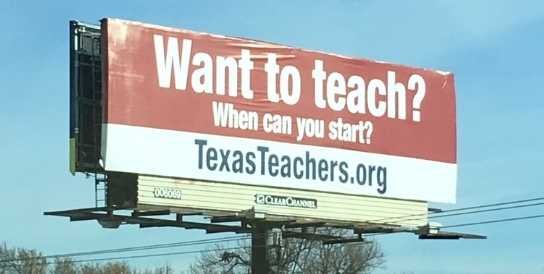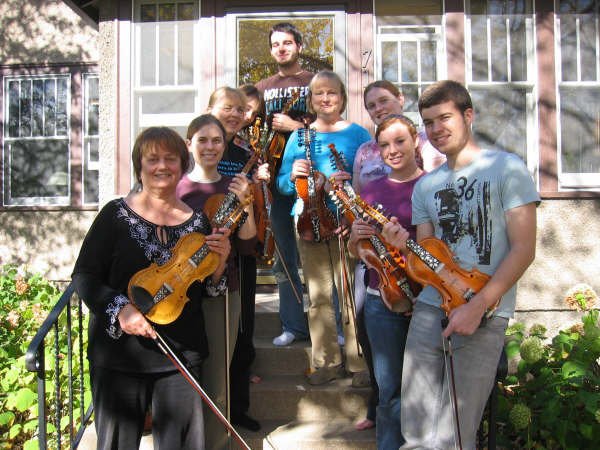When I was a teacher in Texas, every morning on my commute to school I would pass by this billboard:
Image credit: National Council on Teacher Quality
Each time I saw this sign, my mind would cycle through a familiar wave of feelings: concerns about the impact of classrooms led by underprepared teachers… curiosity at how policymakers could be okay with this for teaching, but not for other professions… despair at how this message might further undermine waning public trust in education.
What I didn’t realize at the time was that passing by this billboard would lead me on a journey halfway around the world to answer this question:
How should we train our teachers?
Welcome to “Fjord to Blackboard: Investigating the Norwegian Teacher Training Experience,” where I’ll be chronicling my experience as a Fulbright researcher during the 2023-2024 school year in Oslo, Norway, attempting to answer this question.
A Proper introduction
If we haven’t met, hello - I’m Geoff. I’m a Texas-based educator working in public policy, and am passionate about public education. For the first 12 years of my career I taught science and sex education to middle schoolers, first in rural Mississippi and then in Austin, Texas.
During my time in the classroom I experienced firsthand how public policy could both create and dismantle barriers for learning. For example:
My first classroom in Mississippi was devoid of any books, science equipment, nor simply working air conditioning.
The current Texas state science standards (TEKS) largely ignore climate change, while extreme weather events affecting the state are increasing in both intensity and frequency.
Texas’ Health and Safety standards require sex education teachers to not “promote homosexuality,” and instead tell our students a lie: that being Queer is a criminal offense.
I could never make peace with the inequities of public education in the United States, and wanted to be a part of the work to build an education system rooted in justice, creating conditions that ensure all students and teachers can thrive. If you’re a fan of The West Wing, my beliefs about what needs to happen in education are perhaps best summed up by Sam Seaborn’s vision for public schools:
“‘’Education is the silver bullet. Education is everything. We don’t need little changes, we need gigantic, monumental changes. Schools should be palaces. Competition for the best teachers should be fierce; they should be making six figure salaries. Schools should be incredibly expensive for government and absolutely free of charge to it citizens, just like national defense.’’”
With that in mind, I took a leap of faith: I stepped out of the classroom… for now. This past year, I completed a master’s degree at the University of Texas at Austin’s LBJ School of Public Affairs (hook ‘em), and started working for Deans for Impact. DFI is a nonprofit organization committed to the belief that every child deserves a well-prepared teacher. I was fortunate to work alongside my friend and now colleague Patrick Steck on the policy team at DFI (fun fact: before becoming colleagues, Patrick and I were teammates for the Austin T3 triathlon team). Through working at DFI, I learned how to combine my teaching experience and passion for public policy, advising federal and state-level policy efforts to increase access and affordability to high-quality, practice-based educator-preparation programs.
Little did I know how impactful this work at Deans For Impact would be to my current research in Norway.
Why norway
The number one question I get both from folks in the US and here in Oslo is ‘’Why Norway?’’ While I’ve gotten explanation down to just a few talking points in under 30 seconds, the real answer takes some explaining.
Remember that billboard – ‘’Want to teach? When can you start?’’ It’s an advertisement for a for-profit educator-preparation program that currently trains more than half of all new teachers in Texas, and operates in many other states as well. The program can be completed almost exclusively online over a six-week period, replacing valuable practice-based clinical experiences like student teaching with click-through powerpoints and videos. It is now in the process of losing its accreditation with the state after failing to meet the conditions of an improvement plan, and will no longer be able to prepare new teachers.
While I have deep concerns about the impact of organizations like this who sacrifice quality in the name of expediency, the real culprit is public policy with few regulatory safeguards for teacher quality. I think about it like a game of chess: you can’t really reprimand a pawn on a chessboard for its limited moves, when the rules of the game made some pieces move that way. A recently published Texas House report identifies that one-in-three new teachers do not have a teaching certificate, and 41% leave the profession within five years. Furthermore, many school districts began this school year with hundreds of vacant positions, and 77% of Texas teachers are actively considering leaving the profession, an increase of 19 percentage-points since 2020.
Norway faces similar concerns about their teaching supply. Data from the Norwegian Education Association shows that nearly 20% of teachers do not have formal training, and are hired to fill vacant positions in primarily rural and remote regions with shortages of qualified teachers. Additionally, 53% of active teachers are considering applying to another profession.
A shortage of qualified teachers is not the only concern about teaching shared by Texas and Norway: the two regions are also hoping to improve the professional status of teachers, as well as prepare a high-quality and modern teaching force. Despite these similar challenges, Texas and Norway are undertaking starkly different policy approaches to solve them.
State officials in Texas have steadily deregulated education by increasing the number of pathways into teaching while simultaneously resisting efforts to ‘’raise the bar’’ on the quality of teacher preparation. For example, some innovative programs have removed barriers into the profession (ex. Dallas College’s paid residency apprenticeship creates a pathway for paraprofessionals to become teachers), while the state’s top education official recently described Texas’ exam for teaching certification as “trash.”
Norway on the other hand introduced sweeping reforms in 2017, requiring new teachers to earn a five-year integrated Master’s degree, raised entry and exit criteria, and overhauled their course sequence to emphasize both the theoretical foundations of pedagogy as well as practice-based clinical experiences.
While my research interests are certainly sufficient reason to be in Norway, there are also some personal motivations behind why I wanted to come here. I’m half Norwegian by heritage, and grew up making lefse with my mom and hearing stories about how my ancestors emigrated from Norway. I also attended St. Olaf College (Um Yah Yah) which was founded by Norwegian immigrants, and where I learned to play Norwegian folk music on the hardanger fiddle. While I’m here, I hope to connect with my extended family on this side of the pond, and to visit places where my ancestors once lived.
Me at 19 years old (a literal baby) with my Hardanger fiddle teacher Andrea Een and our studio at St. Olaf College. Hardanger fiddles are a type of modified violin unique to Norway used to play folksongs by memory. If you want to hear what it sounds like, here’s a video of my friend Rachel Nesvig playing a song called Lofthusen.
Lefse I made for Christmas last year using a recipe from our Holm Familien Oppskrifter (Holm Family Recipes) book my mom and her sister made for me and my cousins. Lefse is a potato-based flatbread that is often topped with sweets like lingonberry jam or with brunost (Norway’s famous brown cheese).
Setting Intentions
Blogs are a fickle thing, which is why I’ve had some trepidation about keeping one. I’m worried that I’ll share an unvarnished view that reflects a limited mindset, that it will feel like a vanity project, or that it will face a similar fate as many blogs do and fizzle away. So instead, I’m setting intentions for what this blog is about:
A chance to stay connected with friends, family, and colleagues in the U.S.
A place to track and reflect on my experiences during this incredible opportunity.
To build a habit of writing.
To discern what’s next.
In the upcoming posts, I’ll share more about my research, interesting tidbits about Norwegian culture and customs, the Norwegian education system, adjusting to life overseas, and my photography (can’t have a blog with “Fjord” in the title without actually having a picture of a proper fjord).
While I’ll make sure to share on social media when I publish a blog post here, I’ll invite you to join me on this journey by subscribing below. Ha det bra!




